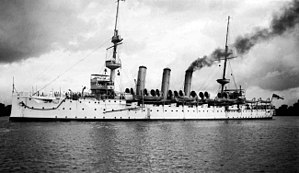HMS Hermes (1898)

HMS Hermes at anchor, Dar es Salaam, German East Africa, before 1913
|
|
| History | |
|---|---|
|
|
|
| Name: | HMS Hermes |
| Namesake: | Hermes |
| Ordered: | 1897 |
| Builder: | Fairfield Shipbuilding & Engineering, Govan |
| Laid down: | 30 April 1897 |
| Launched: | 7 April 1898 |
| Completed: | 5 October 1899 |
| Reclassified: | Fitted to carry seaplanes in 1913 |
| Fate: | Sunk by U-27, 31 October 1914 |
| General characteristics (as built) | |
| Class and type: | Highflyer-class protected cruiser |
| Displacement: | 5,650 long tons (5,740 t) |
| Length: | |
| Beam: | 54 ft (16.5 m) |
| Draught: | 21 ft 6 in (6.6 m) |
| Installed power: |
|
| Propulsion: |
|
| Speed: | 20 kn (37 km/h; 23 mph) |
| Complement: | 470 |
| Armament: |
|
| Armour: |
|
HMS Hermes was a Highflyer-class protected cruiser built for the Royal Navy in the 1890s. She spent much of her early career as flagship for various foreign stations before returning home in 1913 to be assigned to the reserve Third Fleet. The ship was modified later that year as the first experimental seaplane carrier in the Royal Navy. She was used to evaluate in that year's annual fleet manoeuvers how aircraft could cooperate with the fleet and if aircraft could be operated successfully at sea for an extended time. The trials were a success and Hermes was paid off in December at their conclusion. She was recommissioned at the beginning of World War I in August 1914 for service as an aircraft ferry and depot ship for the Royal Naval Air Service. She was torpedoed and sunk by a German submarine in the Straits of Dover in October with the loss of 44 lives.
Hermes was designed to displace 5,650 long tons (5,740 t). The ship had an overall length of 372 feet (113.4 m), a beam of 54 feet (16.5 m) and a draught of 29 feet 6 inches (9.0 m). She was powered by two 4-cylinder triple-expansion steam engines, each driving one shaft, which produced a total of 10,000 indicated horsepower (7,500 kW) designed to give a maximum speed of 20 knots (37 km/h; 23 mph). Hermes reached a speed of 20.5 knots (38.0 km/h; 23.6 mph) from 10,224 ihp (7,624 kW), during her sea trials. The engines were powered by 18 Belleville boilers. She carried a maximum of 1,125 long tons (1,143 t) of coal and her complement consisted of 470 officers and enlisted men.
...
Wikipedia
